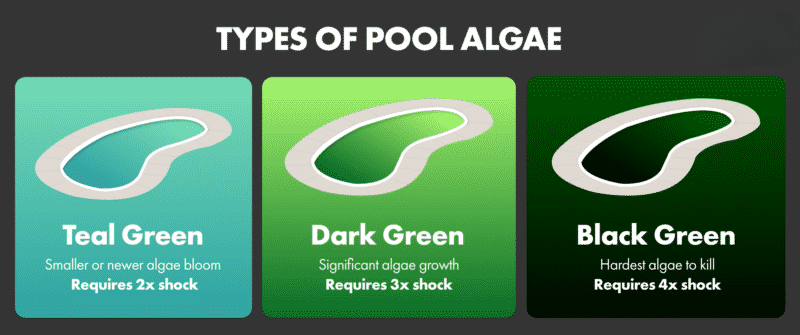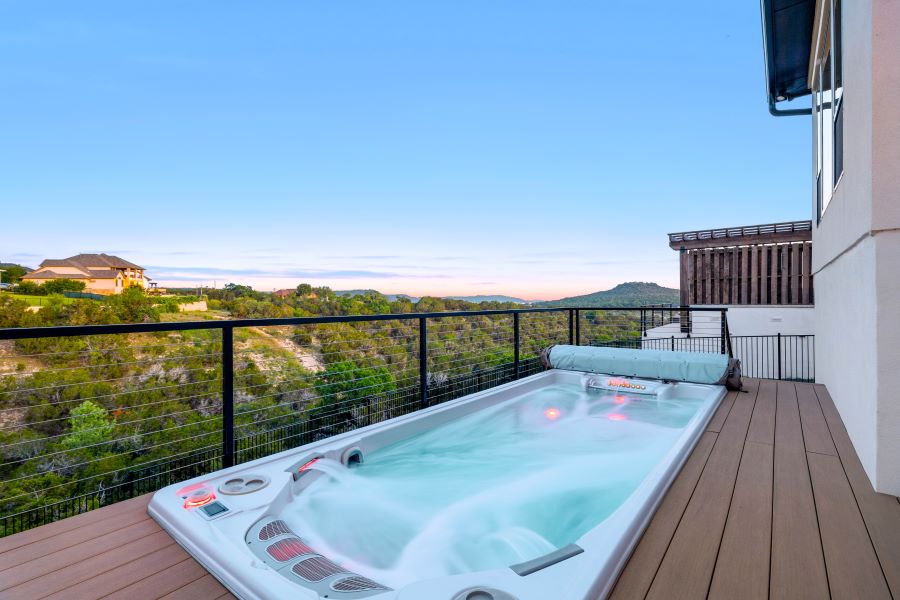Algae in a swimming pool can be a pool owner’s worst nightmare. It turns your once-clear water into a cloudy, green mess and makes swimming unappealing and even unsafe. Many people ask, “Does chlorine kill algae in a swimming pool?” The short answer is yes. Chlorine is one of the most effective treatments for killing algae, but it must be used correctly. In this blog, we’ll explore the different types of algae, how chlorine works to kill algae, and provide steps on how to eliminate and prevent algae growth in your pool.
What is Pool Algae and What Are the Different Types of Pool Algae?

Image Credit: Swimuniversity.com
Algae are microscopic plant-like organisms that thrive in warm, sunny environments, making your swimming pool an ideal place for them to grow. Once they find their way into your pool, algae can spread quickly, clogging your filters and making your water unsafe and uninviting. Pool algae come in three main varieties:
- Green Algae
This is the most common type of pool algae and can turn your water green and cloudy. It forms in spots on the walls, floors, or water surface and grows rapidly if not treated. - Yellow (Mustard) Algae
Yellow algae, sometimes mistaken for pollen or sand, clings to pool walls and is more resistant to chlorine than green algae. It prefers shady areas of the pool and can be harder to remove. - Black Algae
The most stubborn type, black algae, forms dark spots on your pool’s surfaces and can be particularly tough to eliminate because it has deep roots that penetrate plaster and concrete surfaces. Specialized treatments are often needed to remove black algae.
Does Chlorine Kill Algae in a Swimming Pool?
Yes, chlorine kills algae in a swimming pool. As one of the most powerful sanitizers available, chlorine works by oxidizing the algae and other contaminants in the water. Once added to the custom pool, chlorine breaks down the cell walls of algae, killing the organisms and preventing further growth.
However, the effectiveness of chlorine depends on maintaining proper levels in the pool. Low chlorine levels can allow algae to thrive, so it’s crucial to regularly test the water and keep chlorine levels between 1-3 ppm (parts per million) to prevent and treat algae outbreaks.
While chlorine works well against green algae, it may require higher doses or additional treatments to kill more stubborn forms, like yellow and black algae.
Top 3 Steps to Use Chlorine to Kill Algae
If you’ve noticed algae in your pool, follow these steps to use chlorine effectively for removal:
1. Brush the Pool Walls and Floor
- Once the chlorine is added, use a pool brush to scrub the walls and floor of the pool. This helps loosen algae that may be clinging to surfaces, allowing the chlorine to work more effectively.
2. Run the Pump and Filtration System
- Keep your pool pump and filtration system running continuously for at least 8-12 hours to circulate the chlorinated water and filter out dead algae.
- Backwash or clean the filter after the process to remove debris and prevent clogging.
3. Test and Adjust Chlorine Levels
- After shocking the pool, use a water test kit to monitor chlorine levels. You may need to add more chlorine if levels drop too quickly or if algae is still present.
- Maintain proper chlorine levels (1-3 ppm) to ensure algae doesn’t return.
Can pool Shock Alone Kill Algae
- The first step in eliminating algae is to “shock” the pool, which involves adding a high dose of chlorine to the water. This is known as super chlorination.
- To shock the pool, calculate the amount of chlorine needed based on your pool size. For algae removal, you’ll often need to double or even triple the normal dose.
- Distribute the chlorine evenly around the pool, focusing on areas with visible algae growth.
Other Algae-Killing Methods
While chlorine is the most common and effective way to kill algae, there are other methods and treatments you can use, especially for more stubborn algae blooms:
- Algaecides:
Algaecides are chemical treatments designed specifically to kill algae. They work by destroying the algae’s structure and are often used as a follow-up treatment after shocking the pool with chlorine. Some algaecides can also be used preventatively to stop algae from forming in the first place. - Phosphate Removers:
Phosphates are nutrients that algae feed on. By using a phosphate remover, you can starve algae, preventing it from growing. This method is often used alongside chlorine and regular maintenance. - UV and Ozone Systems:
These advanced systems use ultraviolet light or ozone to kill algae spores and other contaminants in the water as it circulates through the pool’s filtration system. While they help reduce algae growth, they should be used in conjunction with chlorine for best results.
How Long Does it Take to Kill Algae
The time it takes to kill algae in a swimming pool depends on the severity of the algae bloom and the method used. With proper chlorine shock treatment, most green algae can be eliminated within 24 to 48 hours. For more stubborn types like yellow or black algae, it may take several days of repeated treatments, including brushing, shocking, and running the pool filtration system. Consistent pool maintenance and monitoring chlorine levels will speed up the process.
How to Prevent Algae Growth in Your Pool
Prevention is always better than cure when it comes to algae in your pool. Here are some tips to keep your pool algae-free:
- Maintain Proper Chlorine Levels:
Regularly check and maintain chlorine levels between 1-3 ppm. This helps prevent algae from growing in the first place. - Run the Pool Filter Daily:
Your pool filter is essential for keeping the water clean and circulating. Run it at least 8 hours a day during the swimming season to prevent algae buildup. - Brush and Vacuum Regularly:
Brush the pool walls and floor weekly to remove algae spores before they have a chance to grow. Use a pool vacuum to clean up any debris. - Monitor Water Chemistry:
Algae thrive in pools with unbalanced water. Regularly test your pool’s pH, alkalinity, and chlorine levels to ensure everything is in balance. - Shock the Pool Regularly:
Even if your pool looks clean, it’s a good idea to shock it every 1-2 weeks, especially during periods of heavy use or warm weather.
When to Call a Professional
While most algae problems can be treated with chlorine and proper pool maintenance, there are times when it’s best to call a professional. If you’re dealing with a severe algae bloom or black algae that won’t go away, a pool professional can provide specialized treatments and equipment to thoroughly clean your pool. They can also inspect your filtration system and water chemistry to prevent future algae outbreaks.
Conclusion
So, does chlorine kill algae in a swimming pool? Yes, it does! Chlorine is an effective sanitizer that can eliminate algae and keep your pool water clean and safe. By following the steps outlined above and maintaining your pool regularly, you can enjoy crystal-clear water all season long. If algae problems persist, don’t hesitate to consult a pool professional for extra help. With the right approach, you can ensure your pool stays algae-free and ready for swimming at any time.


